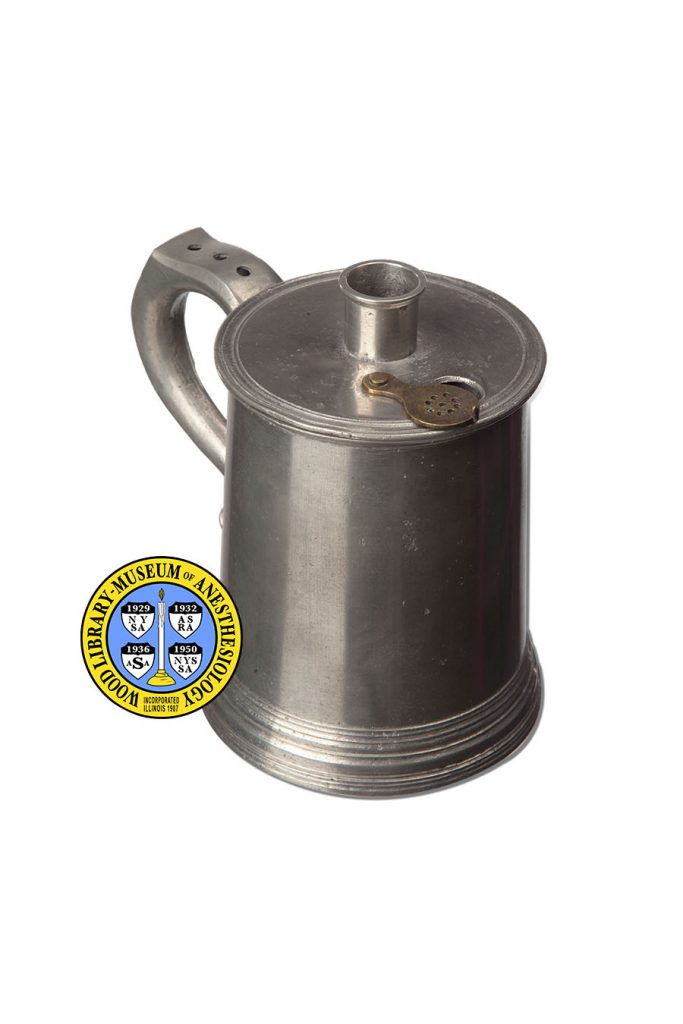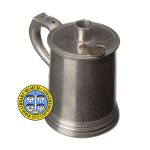Mudge Inhaler
In 1778, English physician and astronomer, John Mudge (1721-1793) published a book in which he described this modified beer tankard, and coined the word “inhaler”. The book was titled, A Radical and Expeditious Cure for a Recent Catarrhous Cough. Used at home and in hospitals, the Mudge Inhaler became popular for the treatment of any illness that caused a cough.
For use, hot water was poured into the bottom of the mug, the lid was closed, and a flexible leather or textile breathing tube was attached to the opening in the cover. The patient would tuck the device under his arm to retain its warmth, and inhale the steam through the tube. Holes were drilled into the top of the hollow handle, mixing fresh air with the steam. Exhaled air passed through the valve in the lid. Herbs and other medicinals, such as opium, or ether, could be added to the water.
When news of Morton’s use of ether for surgical anesthesia first arrived in the United Kingdom, in December 1846, the Mudge Inhaler was a natural choice for administering ether. It was soon replaced by inhalers made specifically for that purpose. Humidification remains a part of the today's respiratory therapies, and of the mechanical ventilation of surgical and intensive care patients.
Catalog Record: Mudge Inhaler Access Key: akhw
Accession No.: 1993-06-30-1 A
Title: [Mudge inhaler / designed by John Mudge.]
Author: Mudge, John, 1721-1793.
Title variation: Alt Title
Title: Mudge ether inhaler.
Title variation: Alt Title
Title: Mudge’s inhaler.
Publisher: [Place of manufacture not indicated] : [Name of manufacturer not indicated], [1780-1920].
Physical Descript: 1 inhaler : pewter, brass ; 13.5 x 15 x 10.5 cm.
Subject: Inhalers, Anesthesia.
Subject: Nebulizers and Vaporizers – instrumentation.
Subject: Respiratory Therapy – instrumentation.
Subject: Ether, Sulphuric.
Subject: Mudge, John, 1721-1793.
Note Type: General
Notes: The broad date range for the possible year of manufacture has been applied
due to the inhaler’s long history and the lack of markings on the instrument
itself. The date range could change if documentation indicates the range
should be corrected.
Note Type: Citation
Notes: Anderson PJ. History of aerosol therapy: liquid nebulization to MDIs to DPIs.
Respir Care. 2005;50(9):1139-1150.
Note Type: Citation
Notes: Index. A Catalogue of Surgical Instruments. London: Arnold and Sons; 1876:
xvii, 217.
Note Type: Citation
Notes: Pharyngeal and laryngeal inflammation. In: Thomas Tegg, ed. The London
Encyclopaedia, or Universal Dictionary of Science, Art, Literature, and
Practical Mechanics, … State of Knowledge. Vol. 14. London: Thomas Tegg;
1829:100.
Note Type: Citation
Notes: Sanders M. Inhalation therapy: an historical review. Prim Care Respir J.
2007;16(2):71-81.
Note Type: Citation
Notes: Sanders M. Pioneers of inhalation: vapour trails & powder monkeys
[presentation slides]. Slides presented at: Drug Delivery to the Lungs –
DDL20; December 9-11, 2009; Edinburgh, Scotland:5-7. https://www.
ddl-conference.org.uk/files/DDL20presentations/19.Sanders.pdf. Accessed July
15, 2013.
Note Type: Citation
Notes: Slatter EM. The evolution of anaesthesia: 1. ether in medicine before
anaesthesia. Brit J Anaesth. 1960;32(1):31-34.
Note Type: Citation
Notes: Slatter EM. The evolution of anaesthesia: 2. the first English ether inhalers
Brit J Anaesth. 1960;32(1):35-45.
Note Type: Physical Description
Notes: One modified tankard made of pewter; The diameter of the tankard (without
handle) at the base is 10 cm; The diameter of the lid is 9 cm; The handle is
hollow with three holes that open to air at the top, and a fourth hole that
opens to the inside of the tankard about 2.5 cm above the bottom; The handle
of this inhaler is not decorated with the ornamental plume of Mudge’s
original design; Extending two cm vertically from the top of the lid with a
cylindrical port for the attachment of a hose or tube from which to breath
through; This inhaler is not accompanied by a breathing tube; The diameter of
the port is approximately 2.3 cm; Also in the top of the lid is an opening,
approximately 1.4 cm in diameter, to a spherical chamber with a small opening
at the bottom; A flat piece of brass, the shape of a small table-tennis
paddle with perforations in the blade, is attached at the ‘handle’ end to the
tankard’s top and can be swiveled to lay over the chamber, or away from it;
The round piece of cork that once occupied this chamber, to act as valve, is
not longer with the inhaler.
Note Type: Reproduction
Notes: Photographed by Mr. Steve Donisch on January 15, 2013.
Note Type: Historical
Notes: Generally beer or cider was consumed from tankards, but this one was modified
to allow the user to inhale medicated vapor or steam. In 1778, English
physician and astronomer, John Mudge (1721-1793) published a book in which he
described his therapeutic device and coined the word “inhaler”. The book was
titled, A Radical and Expeditious Cure for a Recent Catarrhous Cough. Used at
home and in hospitals, the Mudge Inhaler became popular for the treatment of
any illness that caused a cough.
The handle was hollowed-out to create a tube that connected holes drilled
into the top of the handle to the inside of the ‘mug’. For use, hot water and
medicinal substances were added to the bottom of the mug, the lid closed, and
a flexible leather or textile breathing tube was attached to the opening in
the cover. The patient would then inhale deeply to breathe-in a steamy
treatment. Some reached for the Mudge Inhaler to simply inhale the steam of
hot water; others employed herbs and medicines, including opium and ether.
Because inhalers such as this were used to administer ether before its
anesthetic properties were realized, the Mudge Inhaler was a convenient
option for the administration of anesthesia during ether’s introduction in
the UK.
Note Type: Exhibition
Notes: Chosen for the WLM website (noted July 10, 2013).


